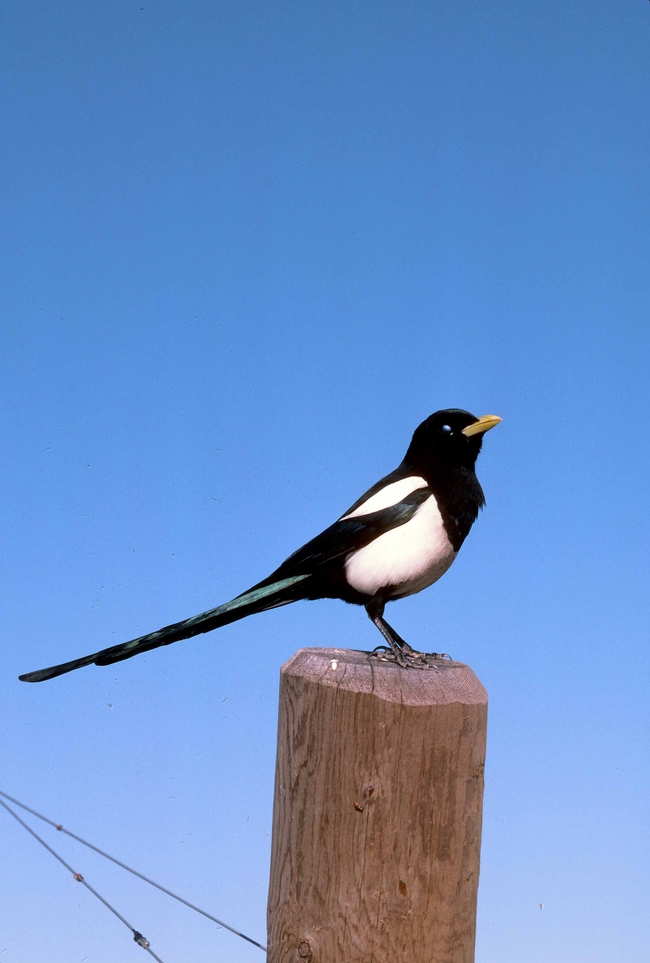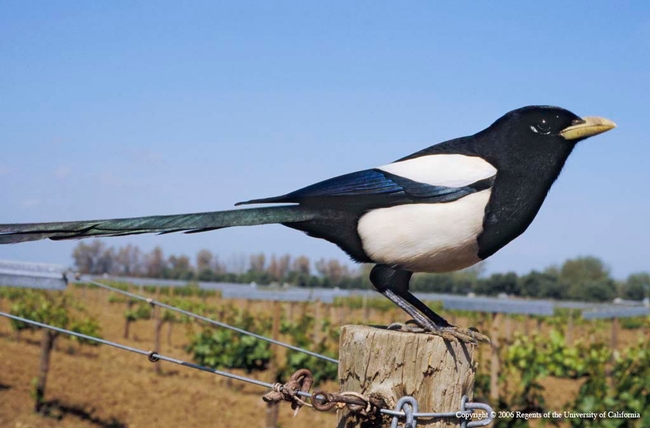Magpies are amazing birds! They are strikingly handsome, intelligent, and bold. They build nests with domed roofs and side entrances and decorate these homes with the bright shiny objects they collect. They hold funeral services for their dead. They can mimic human speech. A cartoon pair, the yellow-billed Heckle and Jeckle, starred in their own TV show from 1956 to 1966.

Scientists believe that ancestral magpies colonized North America about three to four million years ago. They conjecture that the early ice ages and the geological activity that raised up the Sierra Nevada mountains isolated the yellow-billed magpie in the Central Valley. The range of these birds stretches some 500 miles, approximately from Redding to Santa Barbara, covering an area about 150 miles wide down the length of the valley. They have thrived here by adapting to the long hot summers and historically abundant habitat of open oak woodlands and chaparral ecosystems along the valley rivers and in the foothills. The residential and agricultural development of these areas by humans led to loss of wildlife habitat. Magpies have adapted to these conditions by nesting in vacant lots and weedy expanses. They are most often seen where oak woodlands intermix with flatlands, orchards, and agricultural fields.
Yellow-billed magpies are quite large – up to 18-20 inches long with a wingspan of close to two feet. Their markings are a unique combination of black heads, chests, bellies, and backs with broad white patches on their sides. Their wings and tails are characteristically an iridescent, shimmering blue-green. The bright yellow of their bills continues up to surround their shiny eyes (this marking is not always clearly visible).
Before 2004 or so, valley residents could rely on the evening skies being filled with large flocks of yellow-billed magpies flying from their foraging grounds to roost. Then West Nile virus started making its way up the valley. Magpies are especially vulnerable to this virus strain, and it is estimated that in just two years (2004 – 2006) up to 50% of all yellow-billed magpies succumbed to the disease. When safe from disease, magpies are a relatively long-lived bird. The oldest known wild magpie lived to be over 11 years old. In captivity, they can live up to fourteen years.
Gregarious, aggressive, and territorial, the magpie surpasses even the wily blue jay in earning the title of Camp Robber. They steal food from other predators, and even enter campsites and tents to steal food. They will try to destroy the nests of other birds. Their own nests, built by both male and female magpies, are constructed from sticks and twigs, and located far out on high tree limbs. Nests are large (two to three feet in diameter), bulky, and domed, with an entrance on either side. Magpies plaster the interior with a base of mud and line the walls with fine soft plant matter.

Magpies are omniverous, but because their primary diet is insects and rodents, one source claims that they can be considered beneficial to agriculture. (Relatives of mine who grow almonds locally scoff at this idea and consider the magpie a pest.) Their favorite mode of forage is along the ground, mainly for insects, especially grasshoppers, and they will also peck at fallen acorns, almonds, and fruit in fall and winter. They crack through the acorn shell by pounding it with their bills. They also use their bills to flip over cow dung, wood chips, and the like to feast on the insects beneath. Sometimes magpies will stash food items (such as acorns) in shallow holes in the ground or crevices in tree trunks. Carrion is a part of their culinary repertoire, and magpies will attempt to eat recently butchered farm animal carcasses; they will even peck at open wounds created by branding. They are not above picking through garbage at landfills and dump sites. Magpies are opportunists and will ride on the backs of deer for a meal of fleas and other insects. In fact, the word pica, which was first used in the 1500's to denote an odd craving for substances unfit to be used as food (such as chalk or dirt), is a fitting moniker for this bird that will eat just about anything.
Like parrots, magpies can mimic sounds they hear in nature. In human care, magpies have been trained to imitate the human voice and “talk.” Ruckus, a yellow-billed magpie resident at the Turtle Bay Exploration Park in Redding can repeat several phrases, including “I'm smart,” “Hi,” and “I love you.”
A member of my family once witnessed the death ceremony for a magpie that had been killed across the street from their home by a car. They watched while about seven magpies formed a circle around the fallen comrade and 30 or so more magpies gathered in the tree above. After calling loudly for a few minutes, one magpie picked up a leaf, hopped over to the deceased companion (possibly its mate - magpies mate for life), and gently laid the leaf over its body. As a car approached, the ceremony attendees dispersed into the air. Research confirms this observation; as one source notes “when a magpie dies, a gathering of them congregates around the deceased bird where they call out loudly for 10 to 15 minutes.”
Something the scientific facts of these delightful birds do not capture is their raucous and boisterous personality. Magpies love to steal, tease, and “heckle.” While they can create an inhospitable environment for the smaller, prettier songbirds, they never fail to entertain -- just like their trickster, mischief-making cartoon incarnations who love to outwit and play pranks on others.
UC Master Gardeners of Butte County are part of the University of California Cooperative Extension (UCCE) system. To learn more about us and our upcoming events, and for help with gardening in our area, visit our website. If you have a gardening question or problem, email the Hotline at mgbutte@ucanr.edu (preferred) or call (530) 538-7201.